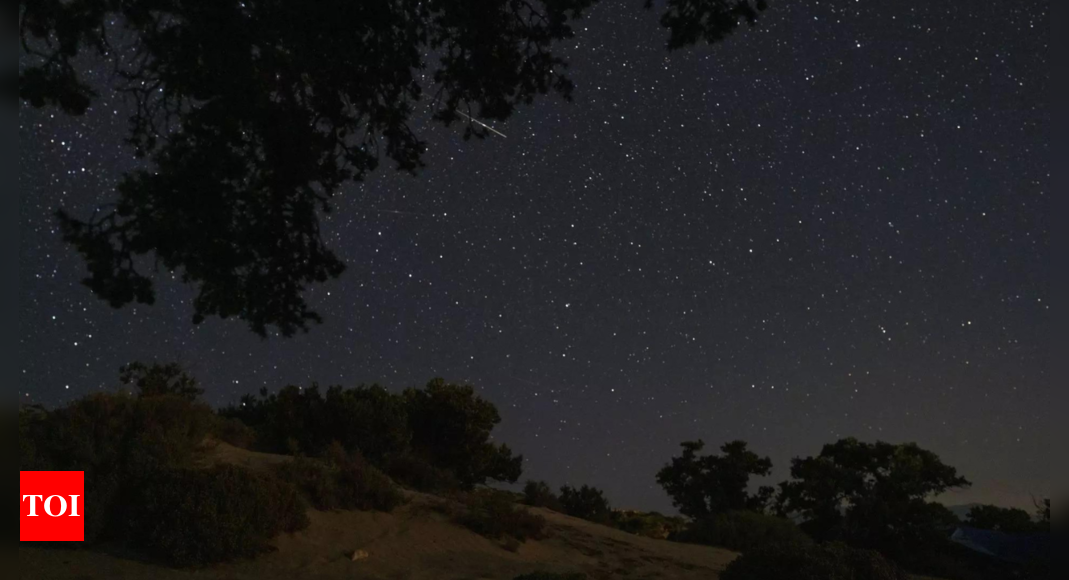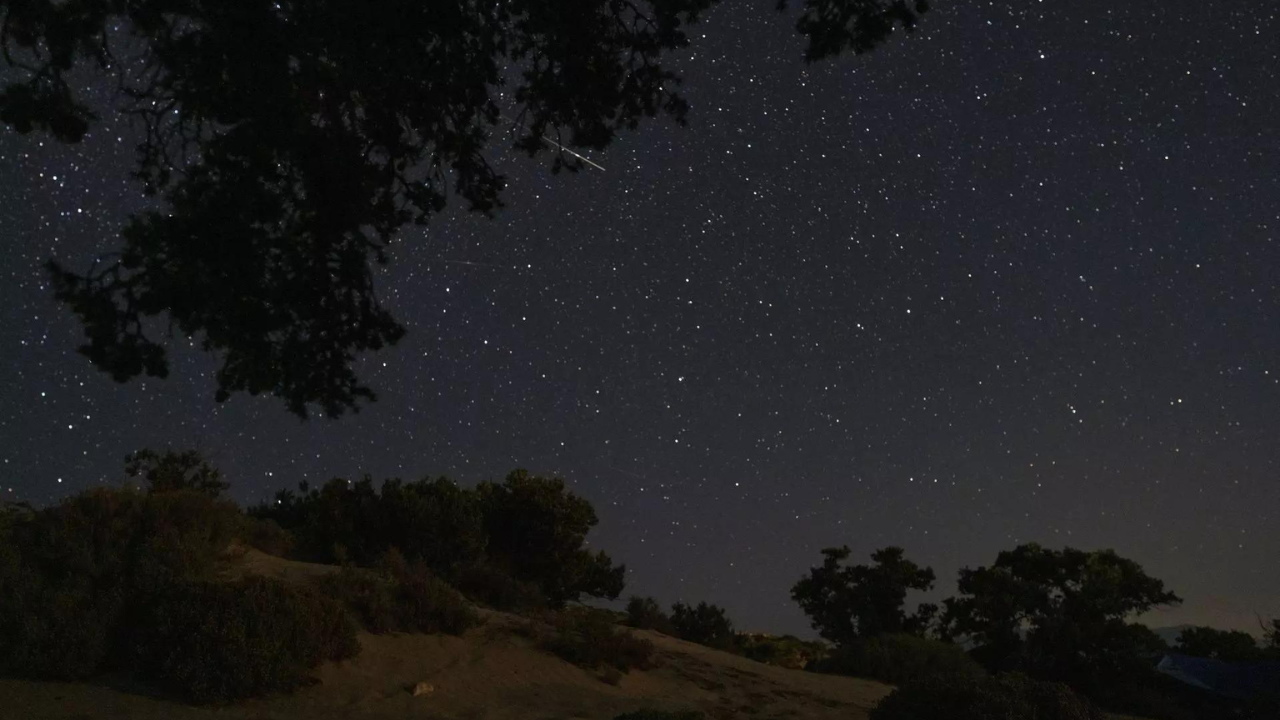The Orinoid meteor shower, which began its celestial display on October 2 and will continue until November 7, is about to reach its peak on October 21. The meteor shower originates from the remnants of Halley’s Comet and offers a unique opportunity to witness shooting stars illuminating the night sky.
Halley’s Comet, a renowned celestial wanderer, orbits the sun every 75-76 years.This meteor shower’s origins lie in the tiny fragments that break away from the comet as it journeys through space. These fragments form a trail of dust and ice debris, which ultimately finds its way into Earth’s atmosphere at a lightning speed of around 41 miles per second. As these particles collide with the Earth’s atmosphere, they burn up due to friction with the air, creating streaks of light that characterize meteor showers.
Halley’s Comet gives rise to not one but two annual meteor showers which occurs because the comet’s orbit closely intersects with Earth’s orbit at two different points. The first point leads to the Eta Aquarids meteor shower in early May, while the second point occurs now, in the middle to latter part of October, producing the Orionid meteor shower.What are the origins of meteor showers?
Meteor showers are celestial events characterized by an abundance of meteors appearing in the night sky over a relatively short period. These meteors, also known as “shooting stars,” materialize when space particles, often remnants of comets or asteroids, enter Earth’s atmosphere and vaporize due to friction.
These celestial phenomena transpire when Earth intersects the path of debris left behind by comets or asteroids during their orbit around the Sun. As these particles from the comet or asteroid enter Earth’s atmosphere, they heat up and vaporize due to friction, resulting in the radiant streaks of light known as meteors or “shooting stars.”
Places to have the best viewing experience
A favorable celestial alignment has made this an excellent time to observe the Orionids. The moon will be in its first-quarter phase and will set at approximately 11:30 pm local daylight time on Saturday, October 21. This means that the moonlight will not interfere with the viewing experience, particularly during the prime predawn hours when the Orionids form the most spectacular visuals. No telescope or binoculars are needed for this show; it will be visible with the naked eye.
People residing in both the Northern and Southern Hemispheres will have plenty of opportunities to witness the meteor shower. Some best places to watch the Orionid meteor shower include New York which is expected to witness only about 15% cloud cover overnight, according to New York Post. Other cities like Miami, Los Angeles, and Atlanta will be favourable as they are expected to have almost no cloud cover. Northern California, with its diverse landscapes and minimal light pollution in certain areas, will be an ideal spot to witness the meteor shower.
Enhancing the viewing experience
To optimize the viewing experience, the viewer should find a dimly lit outdoor area that is free from the glare of streetlights and residential lighting. One should orient themselves to face southeast (for those in the Northern Hemisphere) or northeast (for those in the Southern Hemisphere). It takes about 30 minutes of gazing upwards at the sky for the eyes to adapt and detect meteors. It is recommended to avoid concentrating solely on the star Betelgeuse, the radiant point of the Orionids, in order to fully savor the meteor shower.
Halley’s Comet, a renowned celestial wanderer, orbits the sun every 75-76 years.This meteor shower’s origins lie in the tiny fragments that break away from the comet as it journeys through space. These fragments form a trail of dust and ice debris, which ultimately finds its way into Earth’s atmosphere at a lightning speed of around 41 miles per second. As these particles collide with the Earth’s atmosphere, they burn up due to friction with the air, creating streaks of light that characterize meteor showers.
Halley’s Comet gives rise to not one but two annual meteor showers which occurs because the comet’s orbit closely intersects with Earth’s orbit at two different points. The first point leads to the Eta Aquarids meteor shower in early May, while the second point occurs now, in the middle to latter part of October, producing the Orionid meteor shower.What are the origins of meteor showers?
Meteor showers are celestial events characterized by an abundance of meteors appearing in the night sky over a relatively short period. These meteors, also known as “shooting stars,” materialize when space particles, often remnants of comets or asteroids, enter Earth’s atmosphere and vaporize due to friction.
These celestial phenomena transpire when Earth intersects the path of debris left behind by comets or asteroids during their orbit around the Sun. As these particles from the comet or asteroid enter Earth’s atmosphere, they heat up and vaporize due to friction, resulting in the radiant streaks of light known as meteors or “shooting stars.”
Places to have the best viewing experience
A favorable celestial alignment has made this an excellent time to observe the Orionids. The moon will be in its first-quarter phase and will set at approximately 11:30 pm local daylight time on Saturday, October 21. This means that the moonlight will not interfere with the viewing experience, particularly during the prime predawn hours when the Orionids form the most spectacular visuals. No telescope or binoculars are needed for this show; it will be visible with the naked eye.
People residing in both the Northern and Southern Hemispheres will have plenty of opportunities to witness the meteor shower. Some best places to watch the Orionid meteor shower include New York which is expected to witness only about 15% cloud cover overnight, according to New York Post. Other cities like Miami, Los Angeles, and Atlanta will be favourable as they are expected to have almost no cloud cover. Northern California, with its diverse landscapes and minimal light pollution in certain areas, will be an ideal spot to witness the meteor shower.
Enhancing the viewing experience
To optimize the viewing experience, the viewer should find a dimly lit outdoor area that is free from the glare of streetlights and residential lighting. One should orient themselves to face southeast (for those in the Northern Hemisphere) or northeast (for those in the Southern Hemisphere). It takes about 30 minutes of gazing upwards at the sky for the eyes to adapt and detect meteors. It is recommended to avoid concentrating solely on the star Betelgeuse, the radiant point of the Orionids, in order to fully savor the meteor shower.

